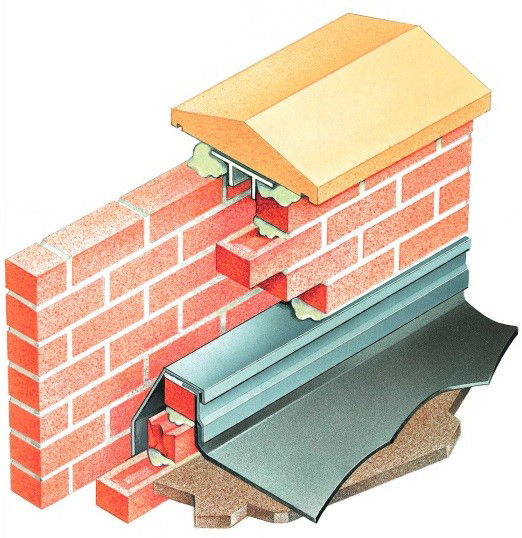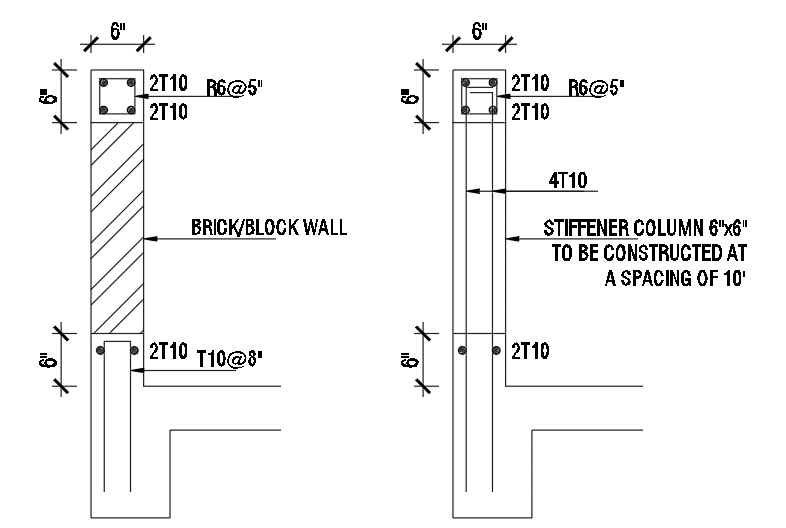
BrickVeneer Parapet Parapet, Brick detail, Timber frame building
Blog Post. Parapet walls behave differently to conventional cavity walls because of their location at the very top of a building where both skins of the parapet are outer skins, and as such are exposed to moisture. Traditionally constructed parapet walls can become saturated with rain and are also subject to extremes of heat and cold, leading.

concrete parapet wall detail Google Search Gypsum Wall, Architecture
There are 2 options for building parapet walls: Standard - where the AB Dogbones connect the facing units together. Easily build corners and parapets with posts. Offers the smallest width, for straight walls only. Wider - where the AB Dogbones act as anchors in the wall rock allowing any size width to be created.

Water intrusion consultations for wet and leaking buildings Decker
Some of the more common ways I have seen the ends of copings detailed include the following: 1) the coping terminates horizontally at or near the surface of the wall cladding; 2) the coping extends into the wall cladding (for example, masonry or EIFS) without an upturned leg and integral side flanges; and 3) the coping terminates within the wall.

How to get it right Parapet walls LABC
🕑 Reading time: 1 minute A parapet wall is a low or dwarf wall built along the edge of the roof, terrace, walkway, balcony etc. Parapet walls can be constructed using different materials like reinforced cement concrete, steel, aluminium, glass etc. Different types of parapet walls and their uses are discussed below. Types of Parapet […]

Remediation details parapets BRANZ Weathertight
Design guide for parapets: Safety, continuity, and the building code. The modern parapet must provide fire protection, serve as a fall-protective guard, transition and protect the roof/facade interface, conceal rooftop equipment, and contribute to the aesthetic character of the building. course credit: 1.0 AIA LU/HSW, 1.0 PDH Provided By: BD+C.

Moisture Management of Parapet Walls Masonry Technology, Inc.
A parapet wall is a low wall or railing that extends above the roofline of a building or other structure, usually found at the edge of a flat roof or balcony. Its primary function is to provide a barrier and prevent people from falling off the roof or balcony.

Image result for parapet wall Membrane, Cladding, The Professional
The parapet is a minor wall around the edge of a roof, balcony, terrace, or stairway, usually covering the roof's perimeter. It protects the top and pre-built structures from corrosion and degradation. The Functions Of The Parapet Wall: Blowing wind creates a vortex on the edges of the roof and causes a gigantic pressure difference.

Parapet Detail Terrace DWG Detail for AutoCAD • Designs CAD
Coping - Construction that protects the top of a wall, balustrade, or parapet and sheds rainwater clear of the surfaces beneath. Capping - Construction that protects the top of a wall, but does not shed rainwater clear of the surfaces of the wall beneath.

TYPICAL PARAPET DETAIL a photo on Flickriver
Parapet Wall Roofing Guide (Exterior Design Types + Construction Details) If you are looking for a quick parapet definition, skip ahead to the first section. Otherwise, choose the table of contents menu below for navigation to the parapet roof section you're most interested in. Table of Contents [ hide] What Is A Parapet? History of Parapets

1RoofParapetDetailAnyFinish
A demonstration of assembling a parapet wall detail using a combination of profiles and composites. Enjoy!!!🟠Project Files; https://tinyurl.com/mxk6bvs6🔵Ar.

Architectural Details
Share Construction of parapet walls can be observed in buildings, bridges, and roads. In general, there will be parapet walls in almost all the buildings. Whether it is low rise building or high rise building, we need parapet walls as mostly there will be roof slabs, terrace need protection.

Moisture Management of Parapet Walls Masonry Technology, Inc.
1. Height of roofing at wall: minimum of 12" to top of parapet. Do not lap TPO over top of parapet unless required by unique construction conditions. 2. Top of parapet, below cap, to be sealed with fluid applied flashing. 3. Venting in wood framed parapets: Provide venting to each wall cavity.

Moisture Management of Parapet Walls Masonry Technology, Inc.
DESCRIBE the design of parapet components, including copings, cladding, sealants, mortar joints, in-wall flashings, and vapor barriers, and explain how each functions to protect wall and roof assemblies from water infiltration. DISCUSS the impact of code requirements for energy performance (e.g., the International Energy Conservation Code) on.

Parapet wall sectional detail dwg file Cadbull
A parapet wall is a barrier at the edge of a roof, terrace, balcony, or other building structure that provides protection from falls. Parapets can be made of brick, stone, concrete, metal, wood or other structural materials. The parapet wall extends above the roof level and may be plain, embattled, perforated or panelled.

Parapet Wall Detail Sketch Parapet, Roof detail, Roof work
DETAIL: Rev. 5 (2014) Reveal™ 1.17 Hardie Reveal™ Panel Vertical Siding • Wood Framing • OSB or Plywood Sheathing • Pressure-Treated Wood Furring (Minimum 3/4" Nominal, 23/32" Actual Thickness) having specific gravity of 0.42 or greater • Shown with Pan Head Screws into Furring 0 SCALE: 1" = 4" 2" 4" VENT STRIP UNDERLAY TO PROVIDE.

Parapet Walls Types, Uses and Construction Structural Guide
Characterized as a low wall, the parapet projects above the roof plane and typically spans around the perimeter of the roof area. Histori-cally, parapets were constructed of masonry, consisting of multi-wythe walls with mortar-fi lled collar joints, capped with a coping.